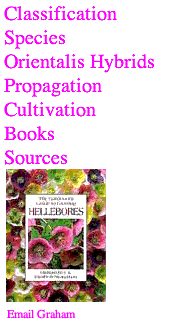

An expanded version of the article in The Garden (February 2001)
Doubles and anemone-centred forms
Double flowered forms come from a number of sources and are exciting many gardeners. Robin White’s Party Dress Group, with its pure colours and outward facing flowers, is derived from wild collected double forms of H. torquatus crossed with good Orientalis Hybrids and has been used by other breeders. ‘Snow Queen,’ the almost pure white double, from Germany, with no torquatus blood, has larger, generally nodding flowers on more vigorous plants. This, and its descendants, have been used more recently.
Breeders of doubles fall into three camps: Robin White does not use the German doubles in his work, for although they are undeniably vigorous he feels that they flower too sparsely and their pendulous flowers counteract his ideal of flowers which face outward. Roger Harvey takes the opposite view, using only the German doubles as he feels those with blood from H. torquatus are prone to disease. John Massey and Richard Bramley have used both groups but select rigorously for vigour, outward facing flowers and resistance to disease.
New doubles still appear by chance, for example in Tasmania John Dudley found a white, double-flowered plant in a large planting of single whites in a neglected garden and named it ‘Mrs Betty Ranicar’; it seems larger and purer in colour than ‘Snow Queen’ and John has used it to breed doubles, including good pinks and some lovely anemone-centred forms.
Anemone-centred types, in which the nectaries have become partially, petaloid, rouse strong opinions - for and against. They are derived from crossing single and double flowered parents, and when crossed with each other produce a mixture of forms. Some are gorgeous, especially one produced by Richard Bramley, a pale picotee with large crimson nectaries. Anemone-centred types seem especially popular in the United States but the difficulty of producing them reliably, except by dividing individual plants, restricts their availability. They are derived from crossing single and double flowered parents, and when crossed with each other produce a mixture of double, single and anemone-centred plants.
Some breeders are trying to improve the foliage to create a better all-the-year-round garden plant and this still continues, crossing Orientalis Hybrids with H. torquatus and especially H. multifidus subsp. hercegovinus to introduce dark or divided foliage. But this is a slow process as at first flower quality deteriorates dramatically and rich foliage colour can be fleeting and often varies with the season.
Some crave variegated forms although Elizabeth Strangman used to throw away variegated seedlings, as others still do, but very few variegated seedlings have proved stable. James W. Waddick has grown on many variegated seedlings but is yet to find a stable one - except for a plant he calls ‘Confetti’, which he received from Germany; its leaves are speckled cream but it has poor flowers. It sounds similar to ‘Graigueconna’, illustrated in In an Irish Garden, which has never been commercially available.
Some breeders are also investigating autumn flowering but it is clear that flowers produced in autumn are often atypical and usually inferior to those produced at the normal season.